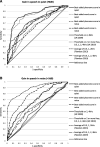Selection Criteria for Cochlear Implantation in the United Kingdom and Flanders: Toward a Less Restrictive Standard
- PMID: 32590629
- PMCID: PMC7757743
- DOI: 10.1097/AUD.0000000000000901
Selection Criteria for Cochlear Implantation in the United Kingdom and Flanders: Toward a Less Restrictive Standard
Abstract
Objectives: The impact of the newly introduced cochlear implantation criteria of the United Kingdom and Flanders (Dutch speaking part of Belgium) was examined in the patient population of a tertiary referral center in the Netherlands. We compared the patients who would be included/excluded under the new versus old criteria in relation to the actual improvement in speech understanding after implantation in our center. We also performed a sensitivity analysis to examine the effectiveness of the different preoperative assessment approaches used in the United Kingdom and Flanders.
Design: The selection criteria were based on preoperative pure-tone audiometry at 0.5, 1, 2, and 4 kHz and a speech perception test (SPT) with and without best-aided hearing aids. Postoperatively, the same SPT was conducted to assess the benefit in speech understanding.
Results: The newly introduced criteria in Flanders and the United Kingdom were less restrictive, resulting in greater percentages of patients implanted with CI (increase of 30%), and sensitivity increase of 31%. The preoperative best-aided SPT, used by both countries, had the highest diagnostic ability to indicate a postoperative improvement of speech understanding. We observed that patient selection was previously dominated by the pure-tone audiometry criteria in both countries, whereas speech understanding became more important in their new criteria. Among patients excluded by the new criteria, seven of eight (the United Kingdom and Flanders) did exhibit improved postoperative speech understanding.
Conclusions: The new selection criteria of the United Kingdom and Flanders led to increased numbers of postlingually deafened adults benefitting from CI. The new British and Flemish criteria depended on the best-aided SPT with the highest diagnostic ability. Notably, the new criteria still led to the rejection of candidates who would be expected to gain considerably in speech understanding after implantation.
Copyright © 2020 The Authors. Ear & Hearing is published on behalf of the American Auditory Society, by Wolters Kluwer Health, Inc.
Conflict of interest statement
The authors have no conflicts of interest to disclose.
Figures


References
-
- Blamey P., Artieres F., Baskent D., et al. (Factors affecting auditory performance of postlinguistically deaf adults using cochlear implants: an update with 2251 patients. Audiol. Neuroto., 2013). 18, 36–47 - PubMed
-
- Bosman A. J., Smoorenburg G. F. (Intelligibility of Dutch CVC syllables and sentences for listeners with normal hearing and with three types of hearing impairment. Int. J. Audiol, 1995). 34, 260–284 - PubMed
-
- Cullen R.D., Higgins C., Buss E., Clark M., Pillsbury H. C., 3rd, Buchman C. A. (Cochlear implantation in patients with substantial residual hearing. Laryngoscope, 2004). 114, 2218–2223 - PubMed
-
- Dowell R.C., Hollow R., Winton E. (Outcomes for cochlear implant users with significant residual hearing. Arch. Otolaryngol Neck Surg, 2004). 130, 575 - PubMed
REFERENCE NOTE
-
- Straaten T.F.K, van der, Burger A.V. M., Briaire J.J., et al. The best preoperative measure to select post-lingually deafened candidates for cochlear implantation. Ear and Hear. Under review April 28, 2020
MeSH terms
Grants and funding
LinkOut - more resources
Full Text Sources
Medical

